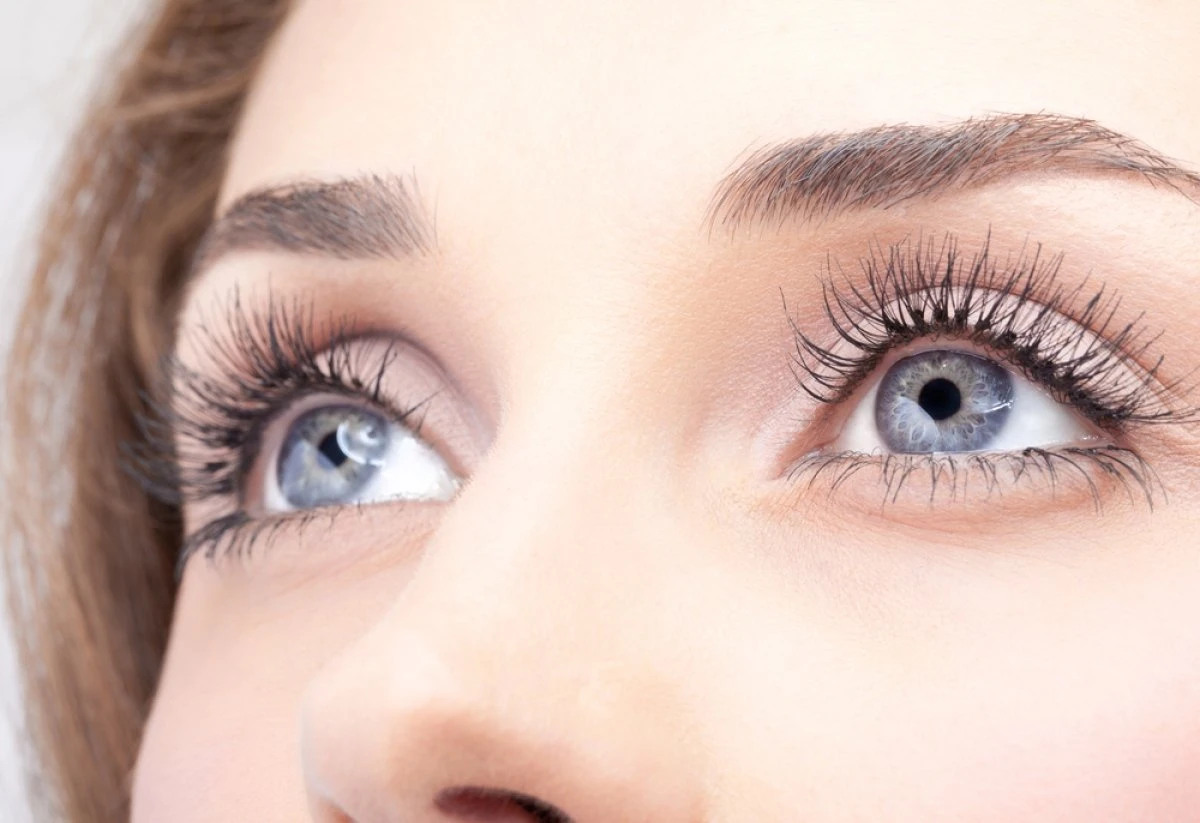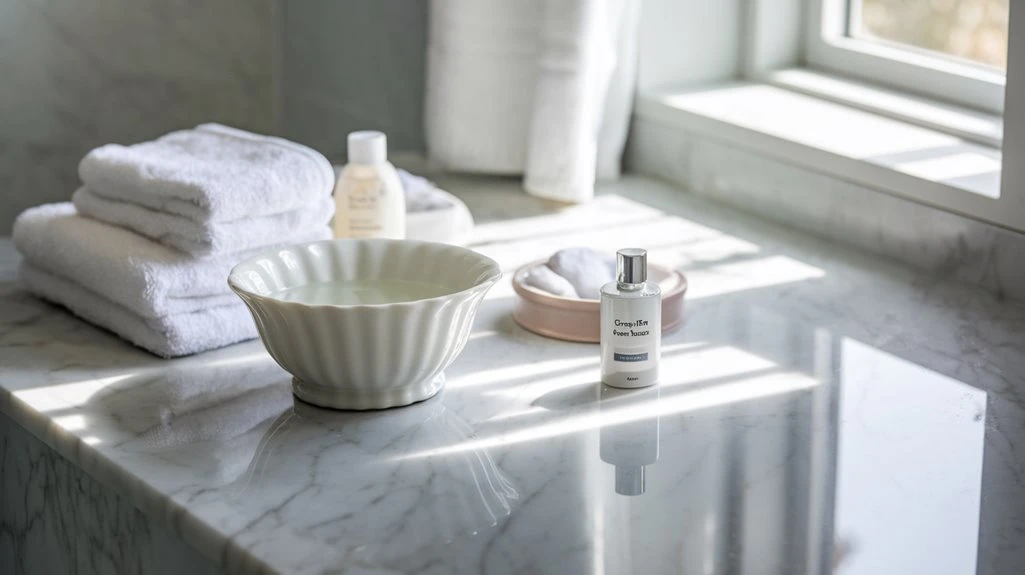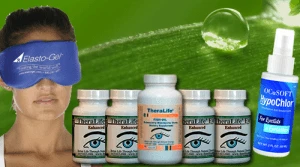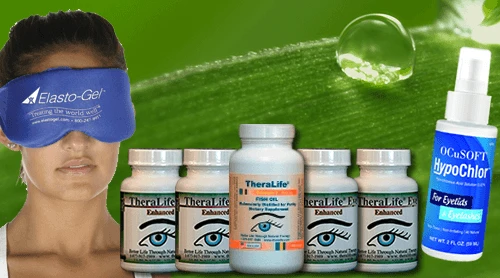To prevent blepharitis flare-ups, TheraLife offers a range of products designed to support optimal eye health. Their approach includes maintaining eyelid hygiene with specialized scrubs that gently massage the eyelids, incorporating diluted tea tree oil for its antimicrobial properties. TheraLife’s warm compresses help liquefy secretions, providing relief and preventing gland blockages. Their hypoallergenic, non-foaming cleansers effectively remove makeup, further reducing the risk of flare-ups. Additionally, TheraLife emphasizes the importance of a diet rich in omega-3s and vitamins A, C, and E to support overall eye wellness. By managing environmental irritants and offering professional consultations, TheraLife provides tailored advice for individual needs. Explore their detailed strategies for transformative eye health management.
Best Blepharitis Treatment From TheraLife
Add To CartKey Takeaways
- Perform consistent eyelid hygiene to reduce bacterial growth and prevent blepharitis flare-ups.
- Apply warm compresses twice daily to alleviate symptoms and unclog blocked meibomian glands.
- Incorporate omega-3 fatty acids in your diet to support eye health and inflammation reduction.
- Use hypoallergenic cleansing products and ensure all cosmetics are removed nightly for optimal eye care.
- Maintain an irritant-free environment with air purifiers and appropriate humidity levels to prevent dry eyes.
Practice Good Eyelid Hygiene
To effectively manage blepharitis, it’s vital to practice good eyelid hygiene. Begin by performing a gentle eyelid massage to dislodge debris and secretions that can exacerbate inflammation.
Use clean fingertips or a specialized eyelid scrub to apply light pressure in a circular motion along the lash line. This technique promotes meibomian gland function and reduces the risk of blockages.
Incorporating essential oils, such as tea tree oil, may offer additional antimicrobial benefits, though it’s important to dilute them properly to prevent irritation.
Consistent implementation of these practices can greatly decrease blepharitis symptoms. Research supports the efficacy of these methods in maintaining eyelid health, emphasizing their role in a thorough blepharitis management strategy.
Evidence-based treatment plans, such as those involving omega-3 fatty acids, have been shown to reduce inflammation, providing further relief for blepharitis symptoms.
Prioritize these techniques for ideal results.
Use Warm Compresses Regularly
Many experts recommend using warm compresses regularly to alleviate blepharitis symptoms. Applying a warm compress increases localized heat, which can effectively liquefy the meibomian gland secretions, enhancing lipid flow. This process helps in reducing eyelid inflammation and unclogging blocked glands, providing significant warm compress benefits. For best results, use compress application techniques that guarantee even heat distribution. Begin by soaking a clean cloth in warm water, then wring it out to avoid excess moisture. Place it gently over your closed eyelids for five to ten minutes, reheating the cloth as necessary to maintain consistent warmth. Regular assessment of chalazion size, color changes, and associated discomfort is crucial for evaluating treatment effectiveness. Regular application, ideally twice daily, supports symptom management, minimizes flare-ups, and contributes to long-term relief from blepharitis discomfort.
Choose the Right Cleansing Products
Selecting appropriate cleansing products plays an essential role in managing blepharitis effectively. The choice of cleansing ingredients determines product effectiveness in controlling this chronic condition.
Opt for hypoallergenic products with gentle surfactants to avoid irritation. Look for formulations containing tea tree oil, known for its antimicrobial properties, which can target Demodex mites, often linked to blepharitis. Additionally, products with sodium hypochlorite can help reduce bacterial load on the eyelids. Regular eyelid hygiene is crucial to minimize symptom recurrence and ensure long-lasting relief from blepharitis symptoms.
Always prioritize non-foaming cleansers, as they minimize residue and further irritation. Ensure the product’s pH aligns with the skin’s natural level, typically around 5.5, to preserve the eyelid’s barrier function.
Regularly assess the product’s impact and consult with an ophthalmologist for personalized recommendations, ensuring the chosen solution remains ideal for your condition.
Be Mindful of Makeup and Contact Lens Use
Be mindful of makeup and contact lens use to minimize blepharitis flare-ups. Select hypoallergenic makeup and contact lens solutions to reduce irritation and allergic reactions. Maintain rigorous hygiene by thoroughly cleaning your eyelids and contact lenses, and avoid sharing cosmetics or eye care products to prevent cross-contamination. Regular eyelid hygiene is essential to reduce bacterial growth contributing to blepharitis. These practices are supported by clinical evidence and greatly decrease the risk of exacerbating symptoms.
Choose Hypoallergenic Products
When managing blepharitis, selecting hypoallergenic products is essential to minimize irritation and prevent flare-ups.
Opt for hypoallergenic skincare to reduce exposure to common allergens. Allergen avoidance is critical, as certain chemicals and fragrances in products can exacerbate symptoms. Look for labels explicitly stating “hypoallergenic” or “fragrance-free” to guarantee compatibility with sensitive eyelids.
Consider switching to hypoallergenic makeup and cleansers, specifically formulated to be non-irritating. Choose products free of parabens, sulfates, and dyes.
For contact lens users, consult your optometrist for hypoallergenic lens solutions to prevent ocular discomfort. Consistently using these carefully selected products helps maintain a healthy ocular surface, decreasing the risk of blepharitis recurrence. Regular cleaning of eye makeup is essential to prevent issues associated with makeup-related eye infections.
Practice Good Hygiene
Maintaining good hygiene is fundamental in managing blepharitis, particularly when it comes to makeup and contact lens use. To minimize flare-ups, confirm all cosmetics are thoroughly removed each night. Residual makeup can block Meibomian glands, exacerbating symptoms.
Incorporate eyelid massage into your routine to improve gland function and facilitate stress reduction, which is crucial for controlling inflammation.
When using contact lenses, adhere to a strict cleaning regimen. Use a disinfecting solution recommended by your eye care professional, and never use saliva or water, which can introduce bacteria.
Replace lenses according to schedule to avoid bacterial growth. By maintaining these hygiene practices, you’ll reduce the risk of blepharitis exacerbations and promote long-term ocular health.
Chronic blepharitis may involve additional factors like Demodex mites, necessitating a comprehensive treatment approach to prevent frequent recurrences.
Avoid Shared Items
While sharing may be caring in many aspects of life, it’s a practice best avoided when it comes to personal items like makeup and contact lenses.
Utilizing shared personal items can increase the risk of bacterial transmission, leading to blepharitis flare-ups. Makeup applicators and contact lenses can harbor bacteria, fungi, and other pathogens, especially when stored or used in communal spaces.
Avoiding these shared items is essential to maintaining ocular health. Always use your own makeup and contact lenses to reduce contamination risks.
Guarantee proper storage and cleaning of your personal items to further minimize potential infections. By being vigilant about what you share, you can effectively prevent blepharitis symptoms and enjoy long-lasting relief from discomfort.
Regular eyelid hygiene and proper care help control bacterial overgrowth, further reducing the chances of developing blepharitis symptoms.
Maintain a Balanced Diet
To effectively manage blepharitis flare-ups, prioritize a diet rich in omega-3 fatty acids, which have anti-inflammatory properties that support ocular surface health. Confirm adequate hydration to maintain ideal tear film function, as dehydration can exacerbate eye irritation. Incorporate vitamins A, C, and E to enhance eye wellness, as they play a critical role in maintaining the integrity of ocular tissues. Omega-3 fish oil improves oil film production by meibomian glands, which alleviates dry eye symptoms.
Omega-3 Fatty Acids
Incorporating omega-3 fatty acids into your diet can greatly reduce the risk of blepharitis flare-ups. Omega-3 sources such as fatty fish (salmon, mackerel), flaxseeds, and walnuts are rich in eicosapentaenoic acid (EPA) and docosahexaenoic acid (DHA). These essential fatty acids exhibit anti-inflammatory properties that help maintain the health of the meibomian glands, reducing eyelid inflammation and irritation. The benefits omega-3 provide extend to enhancing tear stability and quality, vital for preventing blepharitis symptoms. Clinical studies have demonstrated that individuals with higher omega-3 intake experience fewer blepharitis episodes. To achieve ideal results, guarantee a consistent intake of omega-3-rich foods or consider high-quality supplements after consulting a healthcare professional, thereby promoting ocular surface health and long-term relief. TheraLife Omega-3 offers a higher potency and purity compared to typical health store fish oils, making it a valuable option for maintaining eye health and reducing inflammation.
Hydration and Eye Health
Ensuring proper hydration plays an essential role in maintaining eye health and can greatly impact the management of blepharitis. Consuming adequate fluids supports the hydration benefits, helping to maintain ideal eye moisture levels. This is vital because the tear film, composed mostly of water, provides essential lubrication, protection, and nourishment for your eyes. Dehydration can lead to an insufficient tear film, exacerbating blepharitis symptoms like redness, irritation, and crustiness along the eyelid margins. Implementing a balanced diet rich in water-containing foods, such as fruits and vegetables, can enhance hydration. Remember, it’s not just about drinking water; ensuring your body efficiently retains fluids is equally important. Proper hydration is a simple yet effective strategy for promoting ocular health and mitigating blepharitis flare-ups. Additionally, incorporating omega-3 fatty acids from sources like oily fish can further support tear production and overall eye health.
Vitamins for Eye Wellness
While maintaining a balanced diet, specific vitamins play an essential role in promoting eye wellness and managing blepharitis. Vitamin A is fundamental for overall eye health and supports the production of eye moisture, which is necessary in alleviating dry eye symptoms. Vitamin E helps maintain this moisture, protecting your eyes from oxidative stress. Vitamin C offers antioxidant protection, preventing free radical damage. Additionally, B vitamins, particularly B6, B12, and folic acid, can reduce eye fatigue and improve your eye function.
To emphasize these benefits:
| Vitamin | Benefit |
|---|---|
| Vitamin A | Enhances eye health |
| Vitamin E | Maintains eye moisture |
| Vitamin C | Provides antioxidant protection |
Incorporating these vitamins into your diet can greatly improve eye health and help prevent blepharitis flare-ups.
Manage Your Environment
To effectively manage blepharitis flare-ups, it’s crucial to optimize your environment by minimizing exposure to common irritants.
Start by controlling the eye environment to reduce allergen exposure. Utilize air purifiers to eliminate airborne particles like dust and pollen, which can exacerbate symptoms.
Maintain humidity levels between 30-50% to prevent dry eyes, a common trigger for blepharitis. Regularly clean bedding and curtains to remove dust mites and other allergens.
Avoid using scented candles or air fresheners that may contain irritants. When outdoors, wear wraparound sunglasses to protect against wind, pollen, and other environmental factors.
Consider hypoallergenic products, including skincare and haircare items, to further reduce the risk of irritation.
These strategies can greatly decrease blepharitis flare-ups.
Best Blepharitis Treatment From TheraLife
Add To CartSeek Professional Advice When Needed
Managing your environment is an effective strategy to reduce blepharitis flare-ups, but seeking professional advice when symptoms persist is critical.
Persistent symptoms like redness, irritation, or eyelid crusting necessitate a professional consultation. The importance of this step can’t be overstated, as delayed treatment may exacerbate the condition.
Ophthalmologists or optometrists can provide professional recommendations tailored to your specific needs. They might suggest treatments such as prescription medications or specialized hygiene routines.
Furthermore, a thorough examination can rule out underlying conditions that mimic blepharitis, ensuring accurate treatment. Regular follow-ups can help monitor your progress and adjust your treatment plan as needed.
Don’t wait for symptoms to worsen; consult a professional for long-lasting relief and effective management.
Best Blepharitis Treatment From TheraLife
Add To CartFrequently Asked Questions
Can Stress Contribute to Blepharitis Flare-Ups?
Yes, stress can contribute to blepharitis flare-ups. It affects your body’s immune response, potentially exacerbating symptoms.
By incorporating stress management techniques, like mindfulness or exercise, you can support your emotional wellbeing and reduce flare-up frequency.
Studies indicate that managing stress decreases inflammatory markers, which might alleviate blepharitis symptoms.
It’s essential to monitor stress levels, as maintaining emotional balance can play a significant role in minimizing ocular surface inflammation.
Are There Any Home Remedies for Immediate Blepharitis Relief?
You’re looking for immediate blepharitis relief, and some effective home remedies can help.
Apply warm compresses to your eyelids for 5-10 minutes; they’ll loosen up crusts and unclog oil glands.
Incorporating tea tree oil is beneficial too, as it has antimicrobial properties. Dilute a few drops in a carrier oil, then gently clean your eyelids.
Evidence suggests these methods can alleviate discomfort and reduce inflammation associated with blepharitis.
How Does Screen Time Affect Blepharitis Symptoms?
Excessive screen exposure can exacerbate blepharitis symptoms due to digital eye strain, reducing blink rate and causing tear film instability.
When you stare at screens for prolonged periods, your eyes blink less often, leading to increased evaporation of tears. This worsens the inflammation of eyelid margins typical of blepharitis.
Implement the 20-20-20 rule: every 20 minutes, look at something 20 feet away for at least 20 seconds to mitigate symptoms.
Can Allergies Trigger Blepharitis?
Yes, allergies can trigger blepharitis. When you’re exposed to allergens, your body’s immune response can exacerbate allergy symptoms, including itchy, watery eyes.
This inflammation can contribute to the onset or worsening of blepharitis by affecting the eyelid margins.
It’s crucial to integrate effective eye care practices, like using hypoallergenic products and maintaining eyelid hygiene, to mitigate these effects.
Addressing both allergy management and eyelid care can provide relief and prevent flare-ups.
Does Hydration Play a Role in Managing Blepharitis?
Yes, hydration’s essential in managing blepharitis.
Maintaining ideal moisture balance in your body supports tear film stability, reducing inflammation and ocular surface irritation. Hydration benefits include enhanced eye lubrication and reduced risk of gland dysfunction.
Empirical studies suggest that adequate water intake can improve mucin production, vital for tear film integrity.
Best Blepharitis Treatment From TheraLife
Add To CartConclusion
Theralife’s comprehensive approach to treating blepharitis focuses on long-term relief through innovative products and expert advice. Their range of products, like the Theralife Eye Enhanced formula, is designed to address the root causes of blepharitis and dry eye syndrome. By improving tear production and reducing inflammation, Theralife provides a holistic solution that goes beyond temporary relief.
Theralife also emphasizes the importance of lifestyle changes, such as maintaining eyelid hygiene and following an anti-inflammatory diet, to complement their product line. Their resources guide customers in selecting safe and effective eyelid cleansers, choosing appropriate eye makeup, and understanding the impact of diet on eye health. For those struggling with recurrent issues like chalazion or uveitis, Theralife offers natural treatment options that focus on healing from within.
By combining scientifically-backed supplements with practical lifestyle adjustments, Theralife empowers customers to manage their blepharitis symptoms effectively, resulting in healthier eyes and improved overall well-being.





